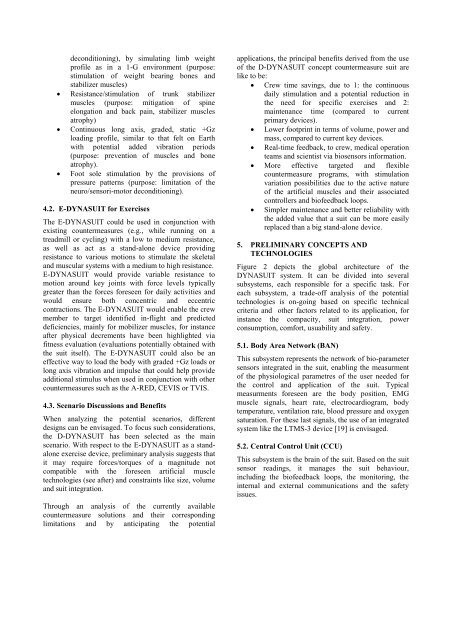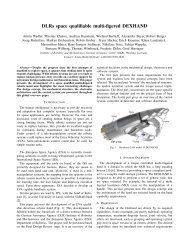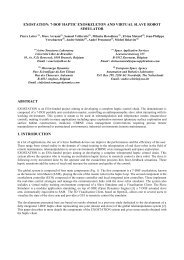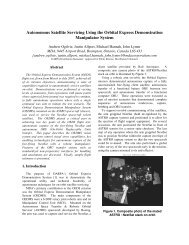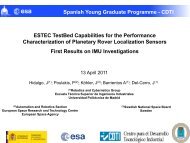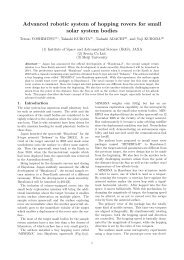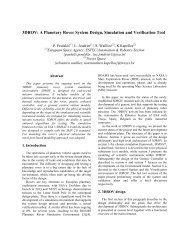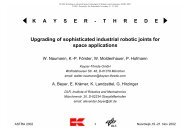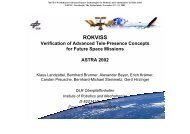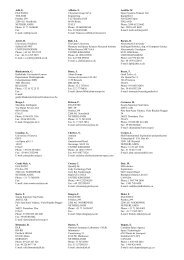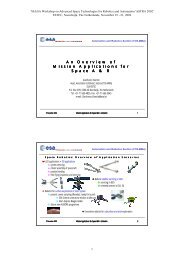DYNASUIT, an Intelligent Space Countermeasure - ESA - Robotics
DYNASUIT, an Intelligent Space Countermeasure - ESA - Robotics
DYNASUIT, an Intelligent Space Countermeasure - ESA - Robotics
Create successful ePaper yourself
Turn your PDF publications into a flip-book with our unique Google optimized e-Paper software.
deconditioning), by simulating limb weight<br />
profile as in a 1-G environment (purpose:<br />
stimulation of weight bearing bones <strong>an</strong>d<br />
stabilizer muscles)<br />
� Resist<strong>an</strong>ce/stimulation of trunk stabilizer<br />
muscles (purpose: mitigation of spine<br />
elongation <strong>an</strong>d back pain, stabilizer muscles<br />
atrophy)<br />
� Continuous long axis, graded, static +Gz<br />
loading profile, similar to that felt on Earth<br />
with potential added vibration periods<br />
(purpose: prevention of muscles <strong>an</strong>d bone<br />
atrophy).<br />
� Foot sole stimulation by the provisions of<br />
pressure patterns (purpose: limitation of the<br />
neuro/sensori-motor deconditioning).<br />
4.2. E-<strong>DYNASUIT</strong> for Exercises<br />
The E-<strong>DYNASUIT</strong> could be used in conjunction with<br />
existing countermeasures (e.g., while running on a<br />
treadmill or cycling) with a low to medium resist<strong>an</strong>ce,<br />
as well as act as a st<strong>an</strong>d-alone device providing<br />
resist<strong>an</strong>ce to various motions to stimulate the skeletal<br />
<strong>an</strong>d muscular systems with a medium to high resist<strong>an</strong>ce.<br />
E-<strong>DYNASUIT</strong> would provide variable resist<strong>an</strong>ce to<br />
motion around key joints with force levels typically<br />
greater th<strong>an</strong> the forces foreseen for daily activities <strong>an</strong>d<br />
would ensure both concentric <strong>an</strong>d eccentric<br />
contractions. The E-<strong>DYNASUIT</strong> would enable the crew<br />
member to target identified in-flight <strong>an</strong>d predicted<br />
deficiencies, mainly for mobilizer muscles, for inst<strong>an</strong>ce<br />
after physical decrements have been highlighted via<br />
fitness evaluation (evaluations potentially obtained with<br />
the suit itself). The E-<strong>DYNASUIT</strong> could also be <strong>an</strong><br />
effective way to load the body with graded +Gz loads or<br />
long axis vibration <strong>an</strong>d impulse that could help provide<br />
additional stimulus when used in conjunction with other<br />
countermeasures such as the A-RED, CEVIS or TVIS.<br />
4.3. Scenario Discussions <strong>an</strong>d Benefits<br />
When <strong>an</strong>alyzing the potential scenarios, different<br />
designs c<strong>an</strong> be envisaged. To focus such considerations,<br />
the D-<strong>DYNASUIT</strong> has been selected as the main<br />
scenario. With respect to the E-<strong>DYNASUIT</strong> as a st<strong>an</strong>dalone<br />
exercise device, preliminary <strong>an</strong>alysis suggests that<br />
it may require forces/torques of a magnitude not<br />
compatible with the foreseen artificial muscle<br />
technologies (see after) <strong>an</strong>d constraints like size, volume<br />
<strong>an</strong>d suit integration.<br />
Through <strong>an</strong> <strong>an</strong>alysis of the currently available<br />
countermeasure solutions <strong>an</strong>d their corresponding<br />
limitations <strong>an</strong>d by <strong>an</strong>ticipating the potential<br />
applications, the principal benefits derived from the use<br />
of the D-<strong>DYNASUIT</strong> concept countermeasure suit are<br />
like to be:<br />
� Crew time savings, due to 1: the continuous<br />
daily stimulation <strong>an</strong>d a potential reduction in<br />
the need for specific exercises <strong>an</strong>d 2:<br />
mainten<strong>an</strong>ce time (compared to current<br />
primary devices).<br />
� Lower footprint in terms of volume, power <strong>an</strong>d<br />
mass, compared to current key devices.<br />
� Real-time feedback, to crew, medical operation<br />
teams <strong>an</strong>d scientist via biosensors information.<br />
� More effective targeted <strong>an</strong>d flexible<br />
countermeasure programs, with stimulation<br />
variation possibilities due to the active nature<br />
of the artificial muscles <strong>an</strong>d their associated<br />
controllers <strong>an</strong>d biofeedback loops.<br />
� Simpler mainten<strong>an</strong>ce <strong>an</strong>d better reliability with<br />
the added value that a suit c<strong>an</strong> be more easily<br />
replaced th<strong>an</strong> a big st<strong>an</strong>d-alone device.<br />
5. PRELIMINARY CONCEPTS AND<br />
TECHNOLOGIES<br />
Figure 2 depicts the global architecture of the<br />
<strong>DYNASUIT</strong> system. It c<strong>an</strong> be divided into several<br />
subsystems, each responsible for a specific task. For<br />
each subsystem, a trade-off <strong>an</strong>alysis of the potential<br />
technologies is on-going based on specific technical<br />
criteria <strong>an</strong>d other factors related to its application, for<br />
inst<strong>an</strong>ce the compacity, suit integration, power<br />
consumption, comfort, usuability <strong>an</strong>d safety.<br />
5.1. Body Area Network (BAN)<br />
This subsystem represents the network of bio-parameter<br />
sensors integrated in the suit, enabling the measurment<br />
of the physiological parametres of the user needed for<br />
the control <strong>an</strong>d application of the suit. Typical<br />
measurments foreseen are the body position, EMG<br />
muscle signals, heart rate, electrocardiogram, body<br />
temperature, ventilation rate, blood pressure <strong>an</strong>d oxygen<br />
saturation. For these last signals, the use of <strong>an</strong> integrated<br />
system like the LTMS-3 device [19] is envisaged.<br />
5.2. Central Control Unit (CCU)<br />
This subsystem is the brain of the suit. Based on the suit<br />
sensor readings, it m<strong>an</strong>ages the suit behaviour,<br />
including the biofeedback loops, the monitoring, the<br />
internal <strong>an</strong>d external communications <strong>an</strong>d the safety<br />
issues.


